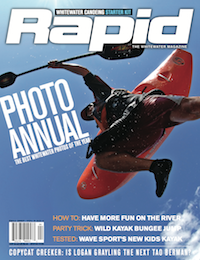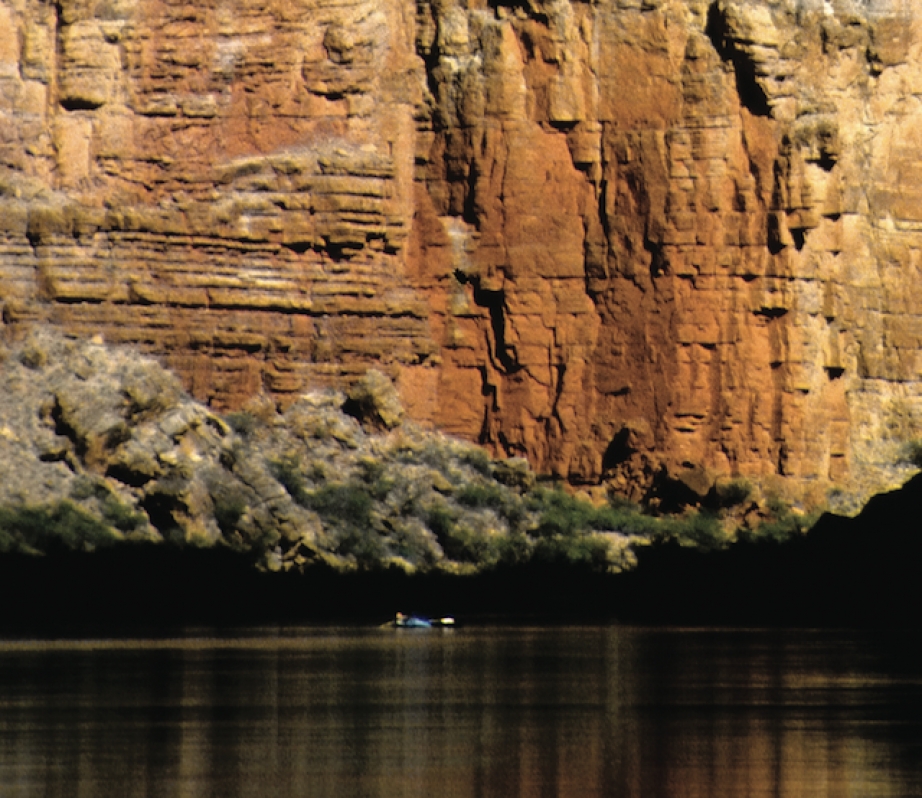It’s a seemingly simple move when done correctly: launch from behind the oars at a run with your coiled bow line and a sand stake; leap to the beach with your raft still in the current; drive the stake into the ground and tie it off like a rodeo calf roper. When done just right, the rope stretches taut and pendulums the raft up onto the sand bar coming to rest where no eddy exists. Miss the timing of the jump, carry too little bow line, or tangle the calf roper loop and the loaded raft keeps on trucking, dragging the boatman down the sandbar on the end of the bow line, heading into the very rapid he intended to scout.
This time the boatman nailed it. She buried the stake with authority and had the rope wrapped and tied in seconds—long before the line came taut. She watched with quiet satisfaction as her raft swung up on the beach, just like it was supposed to. We were above Triplet Falls on the Green River in the desert southwest, the water running high, with her deftly herding passengers off her rig and onto the scout trail. She wasn’t messing around–I was impressed. There was something familiar about this young dynamo of a trip leader. As the last boat on her trip skidded onto the beach and easily tied to her stake, I asked another guide “Is that a young Brown in your lead boat?” He nodded and smiled admirably.
This sense of home, belonging, and ownership will do more for our rivers than anything else in the world. Take care of our rivers.
It was well over 10 years ago when I first landed in Vernal, Utah, to guide the canyon rivers. Vernal was the birthplace of western river running 75 years earlier, but is now all oil drilling and ranching. I had been in town only a couple of days when a rumbly, full-size Ford F350 pickup truck rolled up in a cloud of dust. Out dropped a small, serious-looking man—worn western boots, Wranglers, handlebar mustache and a cowboy hat as big as the grill of his truck. He’d heard there was a Canadian in town. I ran for cover.
Turns out that Cowboy Al loved hockey. He’d come looking for the Canadian kid to come and watch the playoffs with him. It was 1995, New Jersey was playing Detroit.
Al Brown is a legend. He ran rivers for decades in the early days and ended up a dude rancher. In the wintertime he flooded his horse arena and hosted a kids’ hockey league, turning his tack shed into the dressing room, using equipment donated from his wealthy eastern seaboard clients (at the time you couldn’t buy ice skates in Utah).
Cowboy Al was a serious hockey fan in the middle of a hockey desert. As the puck dropped, we became fast friends, meeting in his living room for the playoffs every second night. On off days we’d take shots in his hay barn, blasting pucks at his plywood goalie, Al in his boots and Wranglers, me in sandals and river shorts. While I was on the river he would tape the games and have an edited highlight reel waiting for me when I got back.
Watching hockey at the Brown’s house was serious business too. No one was allowed to talk during play, his three young kids’ eyes glued to the tube. When the game stopped for commercials chaos would erupt with kids brawling and crawling all over each other, shrieking and laughing. When the puck dropped again… silence.
Something I learned from spending my summers on the rivers and at the Brown ranch was Al’s deep love for where he lived. He’d spent most of his life on the Green River, in the canyon of Lodore and Split Mountain, his ranch now on its banks and within view of the take-out. His family was firmly planted, and it was a joy to be invited in.
Named after the canyon where she now guides boats, young Lodore Brown was the trip leader up the trail scouting with her group—the one who nailed the sand stake and the same kid who years earlier pretended to drop her gloves and pull my jersey over my head during breaks in the hockey game.
As she returned her clients to her boat, I introduced myself in the way river guides do—an old-timer nodding and exchanging first names with the new generation, as she focused on her run and getting her rig in order. I didn’t mention watching hockey at her house or taking shots with her dad.
I had just returned to the Green after a long absence and my brief, chance encounter with Lodore made my summer. The sand anchor she so deftly buried and the skill and authority with which she drove it in were symbols of her family history and connection with the place. It is more than “being at home” on the river, this river is her home. I could see it in the depth and clarity of her eyes as she looked over her shoulder at the rapid’s entry in the midst of our brief introduction.
I wish this for all people who travel rivers; I wish them the true feeling of home and connection with a place. The ability to nail a stake into the river bank and know “this is my river.” This sense of home, belonging, and ownership will do more for our rivers than anything else in the world. Take care of our rivers.

This article first appeared in the Fall 2007 issue of Rapid Magazine.



